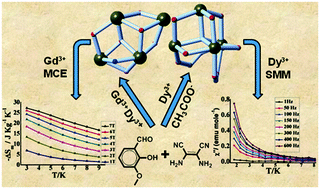Magnetic refrigeration and slow magnetic relaxation in tetranuclear lanthanide cages (Ln = Gd, Dy) with in situ ligand transformation†
Abstract
Three new Ln3+ coordination compounds having formulae, [Gd4(μ3-OH)2(L)2L1L2(HOCH3)2]·11H2O (1), [Dy4(μ3-OH)2(L)2L1L2(H2O)2]·11H2O (2) and [Dy4(μ4-O)(OMe)(HOMe)2(CH3COO)3(L3)2]·2H2O (3), have been synthesized in a one pot synthesis from O-vanillin, diaminomaleonitrile (DAMN), LnCl3·6H2O (Ln = Gd3+, Dy3+) and sodium acetate for 3, {H2L = 2,3-bis((E)-(2-hydroxy-3-methoxy benzylidene) amino)maleonitrile, HL1 = (2-amino-3-((E)-(2-hydroxy-3-methoxy benzylidene)amino)maleonitrile), H3L2 = ((1E,3Z,8Z,10E)-1,6,11-tris(2-hydroxy-3-methoxyphenyl)-2,5,7,10-tetraazaundeca-1,3,8,10-tetraene-3,4,8,9-tetracarbonitrile) and H2L3 = 2-((cyano(2-hydroxy-3-methoxyphenyl)methyl)amino)-3-((E)-(2-hydroxy-3-methoxybenzylidene)amino)maleonitrile. Single-crystal X-ray diffraction studies reveal that compounds 1 and 2 are quasi-isostructural, exhibiting tetranuclear hemicubane-like cores. For 3 the metal centers are arranged in a tetrahedral arrangement. Complexes 1–3 were formed with the ligands (L1–L3), which resulted in situ during synthesis. Magnetic studies reveal that compound 1 shows significant magnetocaloric effect (ΔSm = −27.2 J kg−1 K−1) at 3 K and 7 T. The magnetic properties of 2 and 3 are considerably different. Indeed, no out-of-phase alternating current (ac) signal is noticed for 2, whereas 3 shows a slow relaxation of magnetization. These differences are most likely due to the different Dy–O–Dy angles observed for the respective cores.


 Please wait while we load your content...
Please wait while we load your content...